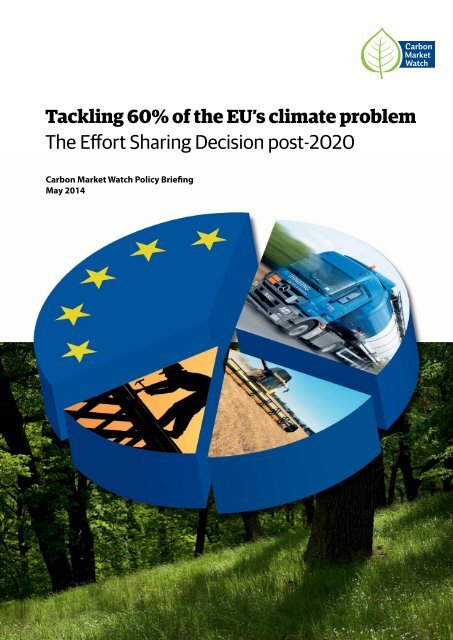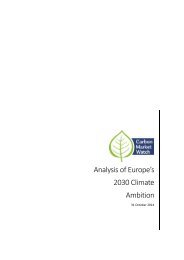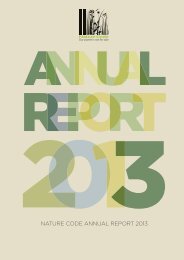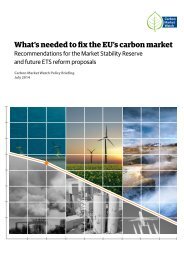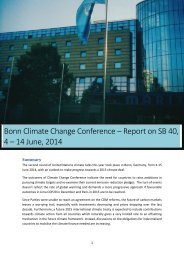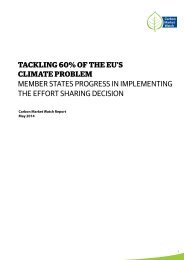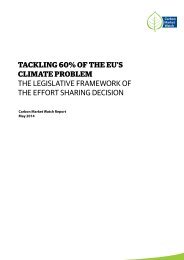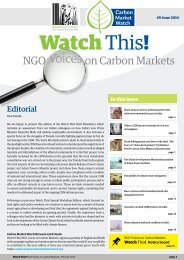Create successful ePaper yourself
Turn your PDF publications into a flip-book with our unique Google optimized e-Paper software.
Tackling 60% of the EU’s climate problem<br />
<strong>The</strong> <strong>Effort</strong> <strong>Sharing</strong> <strong>Decision</strong> <strong>post</strong>-<strong>2020</strong><br />
Carbon Market Watch Policy Briefing<br />
May 2014<br />
1
EXECUTIVE SUMMARY<br />
<strong>The</strong> <strong>Effort</strong> <strong>Sharing</strong> <strong>Decision</strong> (ESD) covers 60% of EU’s total greenhouse gas emissions and is therefore a<br />
centrepiece of Europe’s climate legislation. In contrast to the EU’s Emissions Trading Scheme (ETS) which<br />
started in 2005, the implementation of the ESD only began in 2013. <strong>The</strong>refore, little is known about how<br />
successful it has been tackling the sectors not covered by the ETS.<br />
<strong>The</strong> <strong>Effort</strong> <strong>Sharing</strong> <strong>Decision</strong> establishes linear trajectory of binding emission limits for each Member State<br />
for the 2013-<strong>2020</strong> period and its governance structure is based on annual compliance. According to the first<br />
progress reports from the European Environmental Agency (EEA) (2013), the ESD targets will be overachieved<br />
by up to 50% of the effort required. <strong>The</strong> majority of Member States have therefore not planned significant<br />
additional measures to reduce emissions beyond those that already exist.<br />
Similar to the ETS, the ESD also offers flexibilities and trading options to make it cheaper to comply with the<br />
targets. For example, more than 50% of reduction efforts can be achieved by using international offsets.<br />
Member States have to submit reports on the amount of offsets and other trading options used in 2013 by<br />
January 2016.<br />
<strong>The</strong> current targets, combined with the overgenerous flexibilities, are clearly too weak to drive emission<br />
reductions and delay the implementation of necessary policies for a decade. It is hence no surprise that a<br />
surplus is expected to accumulate in the ESD equal to almost 600 million tons of CO2-eq by <strong>2020</strong>.<br />
Given the importance of reducing emissions in the non-ETS sectors, such as transport, agriculture and<br />
buildings, the lessons learnt with the implementation of the ESD can provide valuable information for<br />
European policymakers for their deliberations regarding the 2030 policy framework for climate and energy.<br />
Recommendations for the 2030 <strong>Effort</strong> <strong>Sharing</strong> <strong>Decision</strong>:<br />
> Strengthen the current governance structure keeping binding emission limits and the<br />
binding annual compliance for each Member State.<br />
> Significantly increase the target to at least 45% emission reductions below 2005 levels by<br />
2030 to fully exploit the cost-effective potential and drive actual emission reductions.<br />
> Do not allow the carry-over of any surplus into the <strong>post</strong>-<strong>2020</strong> period.<br />
> Keep the land use, land-use change and forestry (LULUCF) sector separate from the <strong>Effort</strong><br />
<strong>Sharing</strong> <strong>Decision</strong> and the ETS, without any flexibility options between the different pillars.<br />
> Maintain policies at Union level that contribute to achieving reductions in the non-ETS<br />
sectors inter alia as regards transport and buildings, e.g. ensure the continuation of the Fuel<br />
Quality Directive and establish binding energy efficiency targets.<br />
> Exclude international offsets to meet the 2030 climate obligations.<br />
> Improve the intra-EU flexibilities by establishing harmonized modalities for transactions<br />
between Member States to unlock mitigation potential in poorer Member States, e.g. via<br />
domestic offsetting within the ESD.<br />
2
INTRODUCTION<br />
EU’s <strong>2020</strong> Climate Package includes two main pieces of legislation<br />
to reduce greenhouse gas (GHG) emissions:<br />
1. <strong>The</strong> EU Emissions Trading System Directive (EU ETS) that covers<br />
emissions from large installations in the power and industrial<br />
sectors.<br />
2. <strong>The</strong> <strong>Effort</strong> <strong>Sharing</strong> <strong>Decision</strong> (ESD) that sets emissions reductions<br />
targets for sectors not covered under the EU ETS.<br />
<strong>The</strong> non-ETS sectors account for nearly 60% of the EU’s emissions<br />
and therefore the <strong>Effort</strong> <strong>Sharing</strong> <strong>Decision</strong>, governing these non-<br />
ETS greenhouse gas (GHG) emissions, is one of EU’s central pieces<br />
of climate legislation. <strong>The</strong> current experience with the <strong>Effort</strong> <strong>Sharing</strong><br />
<strong>Decision</strong>, which ends in <strong>2020</strong>, can provide valuable input for<br />
the debate on EU’s 2030 climate and energy framework.<br />
This policy brief takes stock of the lessons learned with the ESD so<br />
far and provides recommendations for the policy design for the<br />
<strong>post</strong>-<strong>2020</strong> <strong>Effort</strong> <strong>Sharing</strong> <strong>Decision</strong>. It is based on two Carbon Market<br />
Watch reports on how mitigation targets in non-ETS sector are<br />
regulated and implemented.<br />
THE EFFORT SHARING DECISION<br />
<strong>The</strong> <strong>Effort</strong> <strong>Sharing</strong> <strong>Decision</strong> sets individual GHG emission<br />
reductions targets for each Member State based on its wealth<br />
as measured by GDP per capita. <strong>The</strong> wealthiest Member States<br />
need to reduce their emissions by 20% below 2005 levels by<br />
<strong>2020</strong> and the poorest is allowed to increase emissions by 20% by<br />
<strong>2020</strong>. <strong>The</strong>se Member State targets add up to an overall EU ESD<br />
reduction target of 10% below 2005 emissions levels by <strong>2020</strong>. <strong>The</strong><br />
EU’s ESD target, together with the EU ETS target add up to the<br />
overall EU climate target of 20% less emissions by <strong>2020</strong> compared<br />
to 1990 levels.<br />
GHG target: -20% compared to 1990<br />
-14% compared to 2005<br />
EU ETS<br />
-21% compared to 2005<br />
Non-ETS sectors<br />
-10% compared to 2005<br />
28 Member State targets, streching from - 20% to + 20%<br />
Figure 1: <strong>The</strong> main elements of EU’s <strong>2020</strong><br />
climate framework<br />
TARGETS AND PENALTIES<br />
<strong>The</strong> ESD establishes binding annual greenhouse gas emission<br />
targets for each Member State for the period 2013-<strong>2020</strong>. In case<br />
of non-compliance, Member States are faced by an automatic<br />
penalty which takes into account the environmental cost of<br />
delaying emission reductions: the excess emissions multiplied by<br />
a factor of 1,08 are added to the emissions of the following year so<br />
that the target becomes more stringent. Until the Member State<br />
is in compliance again it cannot trade its allowances or surplus<br />
with another Member State.<br />
3
FLEXIBILITIES<br />
To make it easier to comply with their<br />
emission targets, Member States are allowed<br />
to use flexibilities. <strong>The</strong>se include inter alia:<br />
• Any overachievement of the target in a<br />
certain year can be banked to a future<br />
year or transferred to other Member<br />
States.<br />
• Member States can borrow from the<br />
following year or transfer to another Member State up to 5%<br />
of their annual target.<br />
• Each year, a Member State is entitled to use offsets up to<br />
the equivalent of 3% of its 2005 non-ETS emissions. Unused<br />
entitlements can be transferred to other Member States or<br />
banked for future use. This means that up to 750 Mton CDM/<br />
JI credits can be used during the period from 2013 to <strong>2020</strong><br />
equal to more than 50% of the overall reduction effort ii .<br />
<strong>The</strong> ESD legislative<br />
framework specifies<br />
only what flexibility<br />
options are allowed,<br />
but it remains silent<br />
about the transaction<br />
modalities. This<br />
allows Member States<br />
to structure their<br />
transactions as they<br />
wish, but at the same time does not provide any guidance on how<br />
the trade between Member States could take place. Currently,<br />
there is no mechanism for using domestic offsetting credits to<br />
comply with the ESD although such project offsets could act as<br />
a modality for transfers between Member States under the ESD.<br />
A domestic offsetting mechanism could be coupled to a Green<br />
Investment Scheme which requires the seller country to invest<br />
the revenues of the sales into other mitigation actions.<br />
“Up to 750 million international<br />
credits can be used during the<br />
2013-<strong>2020</strong> period, equal to more<br />
than half of the overall reduction<br />
effort”<br />
COMPLIANCE<br />
<strong>The</strong> <strong>Effort</strong> <strong>Sharing</strong> <strong>Decision</strong> establishes a binding trajectory up to<br />
<strong>2020</strong>. To show compliance with their binding annual ESD targets,<br />
Member States need to follow an annual reporting cycle from 2013<br />
onwards, as also depicted in figure 2 below. This is a distinctive<br />
feature of the ESD instrument, as other elements of the <strong>2020</strong><br />
climate and energy package do not ensure annual compliance up<br />
to <strong>2020</strong>. <strong>The</strong> Renewable Energy Directive for example only has an<br />
indicative trajectory leading up to the binding <strong>2020</strong> targets for<br />
the share of renewable energy in each Member State.<br />
A panel of experts review the national inventory reports that the<br />
Member States submit to the Commission by 15 March each year.<br />
<strong>The</strong> first report is due in 2015. Once this review is completed,<br />
the emission data for each Member State is finalised after which<br />
that country has four months before its compliance (taking into<br />
account the use of flexibilities) is determined. In case of noncompliance,<br />
the Member State is faced with the aforementioned<br />
penalties.<br />
31 July 2014: <br />
-‐ Approximated <br />
GHG inventory of <br />
2013<br />
15 January 2015: -‐ <br />
Report on 2013 <br />
emissions<br />
Ini;al check of <br />
inventories by <br />
Commission<br />
15 March 2015: <br />
-‐ Na;onal Inventory <br />
Report 2013<br />
30 June 2015:<br />
End of review <br />
period<br />
Figure 2: Reporting cycle related to the ESD compliance<br />
15 January 2016: <br />
-‐ Report on intra-‐<br />
MS AEAu transfers <br />
-‐ Report on use of <br />
interna;onal <br />
credits used for <br />
2013 compliance <br />
31 July 2016: <br />
-‐ Report on <br />
jus;fica;on for using <br />
interna;onal credits <br />
from industrial gas <br />
projects<br />
Commission review of inventories<br />
2014 2015<br />
2016<br />
HOW MEMBER STATES ARE DOING<br />
<strong>The</strong> current ESD target, 10% reduction below 2005 emission<br />
levels by <strong>2020</strong>, can be easily met at no net cost to the European<br />
economy and even delivers net benefits to the economy through<br />
efficiency savings. At EU level, an overachievement of this target<br />
of up to 5% by <strong>2020</strong> is already expected iii .<br />
Overall, the majority of Member States are expected to reach their<br />
<strong>2020</strong> target under the <strong>Effort</strong> <strong>Sharing</strong> <strong>Decision</strong>. See figure 3 below.<br />
A thin majority of Member States is expected to overachieve<br />
their target by between 2% and 44% with already implemented<br />
measures. <strong>The</strong> difference between already implemented and<br />
additional planned measures is relatively small for most of them.<br />
This indicates that most Member States would already achieve<br />
their targets as a result of a business-as-usual trajectory and they<br />
therefore did not need to plan any additional measures.<br />
Also, most of the overachievers are countries that are allowed to<br />
increase their emissions. <strong>The</strong> ESD targets are therefore insufficient<br />
as they lock in a business-as-usual scenario.<br />
4
Figure 3: Member States, their ESD target and trends in meeting their <strong>2020</strong> targets<br />
the EU’s projected greenhouse gas emissions are well below<br />
the <strong>Effort</strong> <strong>Sharing</strong> targets in each year during the 2013-<strong>2020</strong><br />
period. This leads to a build-up of<br />
over-achievement in the ESD equal<br />
to around 600 million tons of CO2-eq.<br />
(with existing measures only) iv . <strong>The</strong><br />
use of international offsets will not be<br />
necessary to achieve the ESD targets<br />
and it would increase the surplus even<br />
further.<br />
“By <strong>2020</strong>, there will<br />
be a surplus of around<br />
600 million tons of<br />
CO2-eq in the ESD”<br />
<strong>The</strong> build-up of surplus is the outcome of weak targets and the<br />
overgenerous flexibilities and will not be the result of additional<br />
reduction efforts. In order to avoid future<br />
inaction and carbon lock-in, any overachievement<br />
of Member States ESD targets<br />
should not be allowed to dilute future climate<br />
efforts. Currently the ESD compliance ends in<br />
<strong>2020</strong> and there are no provisions for carrying<br />
over the surplus to a <strong>post</strong>-<strong>2020</strong> period.<br />
SECTORS AND POLICIES<br />
<strong>The</strong> ESD covers emission sources from fuel<br />
combustion, fugitive emissions from fuels,<br />
industrial processes, solvent and other product use,<br />
agriculture and waste, except for the emissions from<br />
installations covered by the EU ETS. <strong>The</strong> ESD does<br />
not cover emissions from the LULUCF sector. <strong>The</strong><br />
three non-ETS sectors with the largest emissions<br />
are: energy use in road transport (34%), energy use<br />
in households (19%) and emissions from agriculture<br />
(17%) see figure 4.<br />
<strong>The</strong> <strong>Effort</strong> <strong>Sharing</strong> <strong>Decision</strong> sets a GHG target for<br />
these sectors, but does not specify where, how and<br />
with what policies a Member State should reduce its<br />
GHG emissions. <strong>The</strong> choice of measures is therefore<br />
the responsibility of each Member State although<br />
existing EU policies help Member States achieve their<br />
targets. <strong>The</strong>se policies are necessary to overcome the<br />
specific barriers to implement reduction efforts. For<br />
example, measures to reduce transport emissions<br />
are in general relatively expensive, while energy<br />
efficiency measures are faced with non-financial<br />
barriers such as lack of information or split incentives<br />
between building owners and tenants. This shows<br />
that despite capturing the overall greenhouse gas<br />
reductions by the <strong>Effort</strong> <strong>Sharing</strong> <strong>Decision</strong> targets,<br />
there is a need for more action in these specific<br />
sectors.<br />
Figure 4: ESD emissions by sector<br />
5
TRANSPORT<br />
Transport emissions have increased by over one third since 1990<br />
and are the second largest source of EU greenhouse gas emissions<br />
after the power sector. Emissions are projected to decrease by less<br />
than 1% by <strong>2020</strong> from 2005 emissions levels. <strong>The</strong> EU’s objective is<br />
to reduce transport emissions by 20% in 2030 compared to 2008<br />
levels v but this will not happen without further measures.<br />
Existing EU policies that help Member States achieve their ESD<br />
targets include inter alia:<br />
BUILDINGS<br />
Emissions from the building sector have been slowly declining<br />
over the last years, mostly due to energy retrofits in existing<br />
buildings. <strong>The</strong> building sector’s emissions are expected to decline<br />
by 9% from 2005 to <strong>2020</strong>. Around 75% of the projected reductions<br />
under the <strong>Effort</strong> <strong>Sharing</strong> <strong>Decision</strong> are expected to come from<br />
energy efficiency measures in the building sector, vi but the sector<br />
could deliver much higher cost-effective reductions.<br />
Existing EU policies that impact building emissions include inter<br />
alia:<br />
<strong>The</strong> Cars & CO2 Regulation establishes mandatory emission<br />
reduction targets for new cars. <strong>The</strong> fleet average to be achieved<br />
by all new cars is 130 grams of CO2 per kilometre by 2015 and<br />
95g/km by 2021. Currently, cars are responsible for around<br />
12% of EU’s total carbon dioxide emissions.<br />
<strong>The</strong> Fuel Quality Directive requires a reduction of the<br />
GHG intensity of fuels used in vehicles, calculated on a lifecycle<br />
basis, by a minimum 6% by <strong>2020</strong>. <strong>The</strong> policy promotes<br />
cleaner fuels over more carbon-intensive ones and aims to<br />
reduce emissions that result from the extraction, production,<br />
processing and distribution of fuels.<br />
<strong>The</strong> Energy Efficiency Directive includes a set of specific<br />
efficiency measures that Member States and private actors<br />
need to implement to bring the EU closer to achieving its <strong>2020</strong><br />
20% headline target on energy efficiency. Since there are no<br />
binding national energy efficiency targets, the EEA predicts<br />
that the EU will not achieve its headline target. vii<br />
<strong>The</strong> Energy Performance of Buildings Directive establishes<br />
minimum energy performance requirements for new and<br />
existing buildings and mandatory energy certification for all<br />
properties that are constructed, sold or rented out.<br />
AGRICULTURE AND FORESTS<br />
<strong>The</strong> main sources for greenhouse gas emissions from agriculture<br />
are livestock (methane emissions) and fertilizer use (N2O<br />
emissions). Emissions reductions can be achieved by lowering<br />
N2O emissions through improving efficiency of nitrogen fertilizer<br />
use and lower nitrogen input, lowering methane emissions<br />
through improved feed in cattle and through prevention of<br />
emissions from manure storage and application. In contrast, the<br />
LULUCF sector is a net carbon sink and is expected to remain a net<br />
sink until at least 2050.<br />
Currently, the emissions from agriculture are treated in the <strong>Effort</strong><br />
<strong>Sharing</strong> <strong>Decision</strong> while the emissions and removals related to land<br />
use, land use change and forestry (LULUCF)<br />
are excluded from the EU’s <strong>2020</strong> reduction<br />
target. LULUCF should also contribute to<br />
the mitigation efforts necessary to reach<br />
the EU’s climate objectives outside the<br />
scope of the <strong>Effort</strong> <strong>Sharing</strong> <strong>Decision</strong>. LULUCF<br />
emissions and removals are characterised<br />
by potentially large annual fluctuations<br />
and long-time horizons, while there are<br />
uncertainties relating to data reliabilities.<br />
<strong>The</strong>se characteristics make the sector unfit<br />
for inclusion in the <strong>Effort</strong> <strong>Sharing</strong> <strong>Decision</strong> that has an annual<br />
compliance cycle.<br />
A separate LULUCF pillar with adequate national targets gives<br />
an opportunity for a policy approach that reflects the sector’s<br />
particularities like permanence, long time cycles and natural<br />
variability. All LULUCF activities should be included in this pillar;<br />
besides forestry also cropland and grazing land management and<br />
“<strong>The</strong> LULUCF sector<br />
should also contribute<br />
but outside the scope<br />
of the <strong>Effort</strong> <strong>Sharing</strong><br />
<strong>Decision</strong>”<br />
wetland drainage and rewetting. This is necessary to incentivise<br />
mitigation in the whole sector, including addressing emissions<br />
from peat lands. In some Member States the emissions from other<br />
LULUCF activities may even exceed the<br />
removals achieved by the forest activities<br />
by 2030.<br />
A separate mitigation target for the<br />
LULUCF sector at least maintaining the<br />
current carbon sink could also help to<br />
address the missing link between the<br />
energy and land use sector. Currently, the<br />
emissions associated with the removal of<br />
biomass from the ecosystem -including<br />
the change in carbon sink over a certain time frame- are not<br />
accounted for, as in EU’s climate legislation the combustion<br />
of this biomass is wrongly assumed to be “carbon neutral” (i.e.<br />
zero emissions). A mitigation target for the LULUCF sector could<br />
increase the likelihood that bioenergy emissions are not hidden,<br />
but at least until then there should be default emission values for<br />
the combustion of biomass under the ETS and the ESD. Imports<br />
of bio-energy should also not to be counted as carbon neutral.<br />
6
RECOMMENDATIONS FOR THE FUTURE 2030 ESD<br />
KEEP BINDING ANNUAL COMPLIANCE<br />
A new <strong>Effort</strong> <strong>Sharing</strong> <strong>Decision</strong> will be necessary for the 2021-2030<br />
period to ensure that non-ETS emissions continue to decrease<br />
beyond <strong>2020</strong>. <strong>The</strong> current ESD approach combining binding<br />
annual emission limits with automatic penalties if a target is<br />
not met helps to ensure that Member States meet their <strong>2020</strong><br />
objective. <strong>The</strong> current ESD governance system including annual<br />
compliance with the targets should therefore be maintained.<br />
SIGNIFICANTLY HIGHER EFFORT SHARING TARGETS<br />
<strong>The</strong> <strong>Effort</strong> <strong>Sharing</strong> <strong>Decision</strong> currently covers around 60% of<br />
the EU’s greenhouse gas emissions, yet these sectors are only<br />
expected to deliver one third of the emissions reductions up to<br />
<strong>2020</strong>. <strong>The</strong> <strong>2020</strong> ESD target is expected to be overachieved by up<br />
to 50% and is hence too low to drive low-carbon innovation and<br />
efficiency.<br />
<strong>The</strong> 2030 targets need to reflect the full mitigation potential<br />
in the non-ETS sectors. Ambitious 2030 targets for the non-<br />
ETS sectors come with clear benefits for citizens, for example,<br />
building retrofits help shield consumers from rising energy bills<br />
and cleaner transport will reduce illness and premature deaths<br />
associated with air pollution. Cleaner transport also has the<br />
potential to create 350,000 to 450,000 net additional jobs in the<br />
EU by 2030 viii . <strong>The</strong> 2030 reduction target for the non-ETS sectors<br />
should be at least 45% below 2005 levels to be in line with a<br />
climate target of at least 55% by 2030. ix<br />
NO CARRY-OVER OF SURPLUS TO THE 2030 FRAMEWORK<br />
By <strong>2020</strong>, the combined cumulated overachievement of ESD<br />
targets of Member States will correspond to around 600<br />
million ton CO2-eq x . This surplus should not be carried forward<br />
to the period after <strong>2020</strong> as it is the result of weak targets and<br />
overgenerous flexibilities and would seriously undermine the<br />
environmental integrity of EU’s 2030 climate target.<br />
LULUCF IN SEPARATE PILLAR<br />
<strong>The</strong> land use, land-use change and forestry (LULUCF) sector<br />
should be included in EU’s climate policies but not under the<br />
<strong>Effort</strong> <strong>Sharing</strong> <strong>Decision</strong>. <strong>The</strong> sector’s characteristics (annual<br />
fluctuations, long-time horizons, uncertain data reliability) make<br />
it unfit for inclusion in the <strong>Effort</strong> <strong>Sharing</strong> <strong>Decision</strong> that requires<br />
annual compliance. LULUCF is best placed in a separate legal<br />
framework, with a separate emission reduction target (at least<br />
at the level of maintaining the current carbon sink), because<br />
otherwise it risks undermining efforts from the other sectors.<br />
<strong>The</strong> LULUCF pillar should be separate from the <strong>Effort</strong> <strong>Sharing</strong><br />
<strong>Decision</strong> without any possibility of offsetting or credit exchange<br />
between the two pillars. This ensures that any credits earned<br />
from large forest sinks do not result in a reduced effort in those<br />
sectors where major emission reductions are needed. Instead,<br />
a separate LULUCF pillar and target ensures that any emission<br />
reductions or enhancement of carbon sinks in the LULUCF sector<br />
are additional to the economy-wide GHG target and hence, offer<br />
an opportunity for enhancing overall ambition.<br />
KEEP THE ETS AND THE ESD AS SEPARATE INSTRUMENTS<br />
<strong>The</strong> reduction efforts of ETS sectors should remain separate<br />
from those of the non-ETS sectors. When introducing linkages<br />
between the ETS and the ESD, there is a risk that problems<br />
with one instrument will spill-over to the other making both<br />
instruments less effective in driving down emissions. <strong>The</strong><br />
transport, buildings and agriculture sectors have particularities<br />
that do not make them fit for inclusion in the carbon market.<br />
NEED FOR MORE EUROPEAN POLICIES IN THE NON-ETS<br />
SECTORS<br />
Additional European policies could help Member States achieve<br />
their ESD targets, especially in the transport and buildings<br />
sectors. Without further measures, transport emissions are<br />
expected to grow by 74% by 2050 from 1990 levels. It is therefore<br />
important to establish new <strong>post</strong>-<strong>2020</strong> targets for the greenhouse<br />
gas intensity of transport fuels (under the Fuel Quality Directive)<br />
for example. With the right policies the building sector could<br />
deliver much higher cost-effective reductions. <strong>The</strong> lack of binding<br />
national energy efficiency targets currently hampers the EU from<br />
achieving its headline efficiency target and the Energy Efficiency<br />
Directive should therefore be revised to include binding targets.<br />
Binding energy efficiency targets for the year 2030, as called for<br />
by the European Parliament xi, would also enable the EU to reduce<br />
its import dependency of countries like Russia.<br />
NO ROLE FOR INTERNATIONAL OFFSETS<br />
International offsets should not be allowed for compliance<br />
under the future <strong>Effort</strong> <strong>Sharing</strong> <strong>Decision</strong>. <strong>The</strong> current ESD allows<br />
Member States to use around 750 million offsets until <strong>2020</strong>,<br />
equivalent to more than half of the overall reduction effort.<br />
This generous offset allowance will further weaken the <strong>2020</strong><br />
effort sharing targets. Allowing cheap offsets stifles and delays<br />
necessary domestic investments and funds a large share of<br />
international offset projects that have limited environmental<br />
integrity, potentially even leading to an increase in global<br />
emissions xii . Member states should instead spend their scarce<br />
resources on domestic mitigation policies and measures like<br />
improving building efficiency or better public transport. <strong>The</strong><br />
future EU climate targets and commitments to finance emissions<br />
reductions in developing countries should be kept separate.<br />
BETTER FLEXIBILITIES<br />
Better financing mechanisms are needed to help unlock<br />
additional emission reductions in the <strong>Effort</strong> <strong>Sharing</strong> sectors in<br />
the future. Currently, the <strong>Effort</strong> <strong>Sharing</strong> <strong>Decision</strong> includes intertemporal<br />
flexibilities (the possibility for Member States to shift<br />
their reduction effort between compliance years) that may help<br />
to increase the cost-effectiveness of the policy. <strong>The</strong>re is however a<br />
lack of harmonized modalities for transactions between Member<br />
States to unlock mitigation potential in poorer Member States<br />
without inflicting a high cost burden on them. Enactment of a<br />
domestic offset mechanism under the <strong>Effort</strong> <strong>Sharing</strong> <strong>Decision</strong><br />
can help foster cost-effective transfers between Member States.<br />
All future flexibilities have to be designed in such a way so that<br />
they do not undermine overall mitigation targets.<br />
7
Contact information:<br />
Femke de Jong, Policy Officer<br />
femke.dejong@carbonmarketwatch.org<br />
<strong>The</strong> <strong>Effort</strong> <strong>Sharing</strong> <strong>Decision</strong> <strong>post</strong>-<strong>2020</strong> – lessons learnt from the EU’s largest climate instrument<br />
Carbon Market Watch Policy Brief<br />
i. European Environment Agency (2013). Trends and projections in Europe 2013<br />
ii.<br />
Overall effort required calculated as the cumulated difference between 2005 emission levels and yearly AEA caps.<br />
iii. European Environment Agency (2013). Trends and projections in Europe 2013<br />
iv.<br />
European Commission (April 2014), Technical Annex to Kyoto Ambition Mechanism Report<br />
v. European Commission (2011). White Paper on transport<br />
vi.<br />
Barkman A. (2013). <strong>The</strong> non-ETS (NETS) sectors. PPT presentation at the Joint Climate Policy Workshop, Dublin 12-13 Sept. European Environment Agency.<br />
vii. European Environment Agency (2013). Trends and projections in Europe 2013<br />
viii.<br />
ix.<br />
http://www.ricardo-aea.com/cms/assets/MediaRelease/Economic-Assessment-Vehicles-FINAL2.pdf<br />
Oeko-institut (2011). <strong>The</strong> Vision Scenario for the European Union: 2011 Update for the EU-27 (ESD-target deducted from Table A-9)<br />
x. http://carbonmarketwatch.org/wp-content/uploads/2013/10/Hermann_Where-are-we-now-Progress-towards-<strong>2020</strong>-targets.pdf<br />
xi.<br />
xii.<br />
European Parliament resolution (5 February 2014) on a 2030 framework for climate and energy policies.<br />
Offsets from the Clean Development Mechanism may have delivered no more than 40% of the emissions reductions it sold. Here


